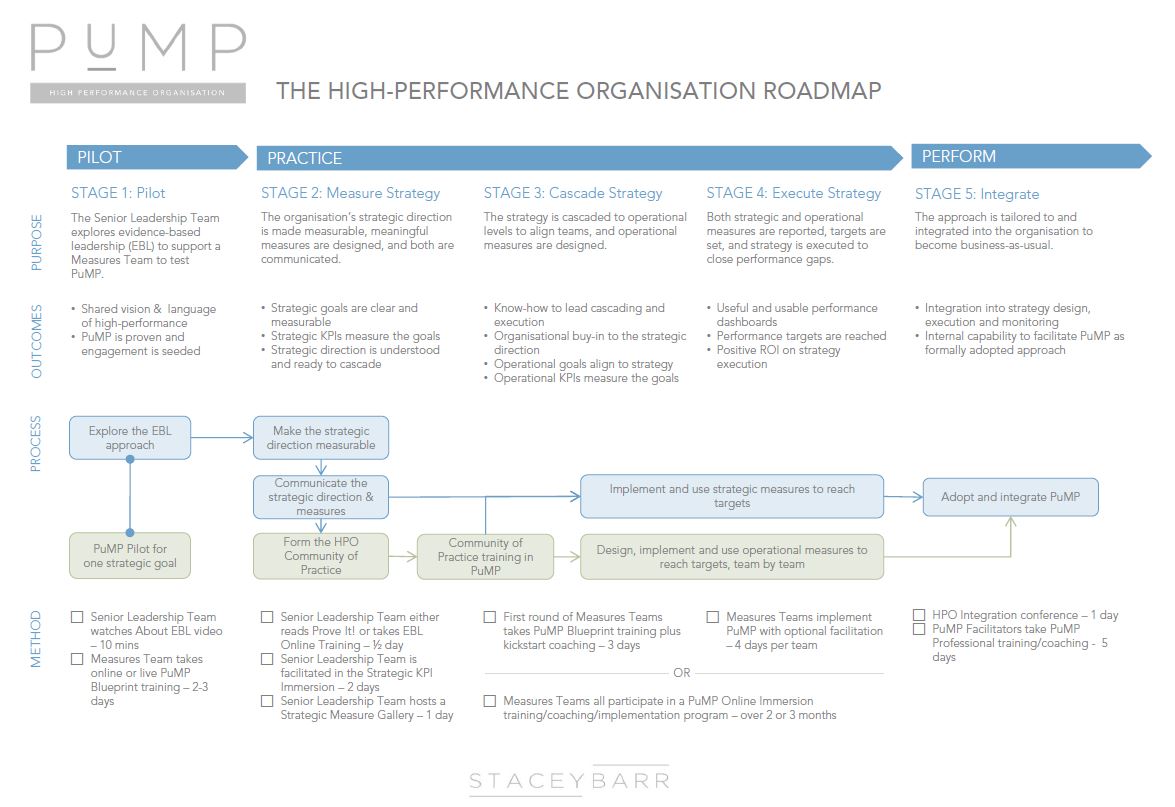How to Deploy a Corporate-Wide Performance Measurement System
by Stacey BarrTo deploy a successful Corporate Performance Measurement System, follow this project plan outline to avoid the pitfalls.
There are several common pitfalls that make a corporate-wide performance measurement system fail before it gets to fly:
- starting too big and overwhelming everyone
- focusing too much on ‘how’ and not enough on ‘why’
- using common, but ineffective, measurement methods
We’ve learned that rolling out a corporate-wide approach to measure performance has to build through iterations, where each iteration can be stronger because it’s built on the foundation of the previous. Much like a nautilus shell.
It’s important to get it right, because it has a massive impact on how quickly and how well you can create a high-performance culture. Do it badly, and you can deepen the fear and
cynicism and avoidance of accountability.
To avoid those pitfalls, design your performance measurement system roll-out project around five stages, and make sure you focus on purpose, outcomes, process and method (our example method is based on PuMP):
Stage 1: Pilot
We avoid the pitfall of starting too big by – you guessed it – starting small. The best, but not the only, way to start small is to begin with helping the senior leadership team to explore evidence-based leadership (EBL) enough that they will hold the space for one Measures Team to test PuMP. We’re aiming for these outcomes at Stage 1:
- Shared vision and language of high-performance
- PuMP is proven and engagement is seeded
The process is two steps. The first is to give the senior leadership team a way to explore EBL, such as giving them a link to this EBL video. The second step is to get a Measures Team together to learn PuMP and take one of the strategic goals through PuMP.
Stage 2: Measure Strategy
The best place to start more meaningful measurement is with the organisation’s strategic direction, and go top-down. There’s no point rolling out the approach organisation-wide until there is a centre for everyone to align to. This stage is crucial for giving everyone a big enough ‘why’ to get involved in measuring performance too. So the strategic direction is made measurable, meaningful measures are designed, and both are communicated. The outcomes are:
- Strategic goals are clear and measurable
- Strategic KPIs measure the goals
- Strategic direction is understood and ready to cascade
The process continues with the senior leadership team now learning the EBL framework, either by reading Prove It! or taking EBL online training. Then they are facilitated through the steps to measure their strategic direction. And they use one of PuMP’s engagement tools, the Measure Gallery, to begin cascading it.
Stage 3: Cascade Strategy
The Measure Gallery creates the buzz around the strategy, and now operational Measures Teams can be formed, to align teams to the strategic direction, and design their own operational measures. But importantly, they all need to follow the same measurement approach, and not regress back into the common approaches that don’t work. The outcomes we’re after here are:
- Know-how to lead cascading and execution
- Organisational buy-in to the strategic direction
- Operational goals align to strategy
- Operational KPIs measure the goals
The process reaches a point where more people need training in the performance measurement method, PuMP. The first round of Measures Teams takes PuMP Blueprint training, and with optional coaching, they kick off by aligning their operational goals to the strategic goals.
Stage 4: Execute Strategy
Now all the new measures get implemented. Both strategic and operational measures are reported, targets are set, and the measures are used to execute strategy and close performance gaps. We see these outcomes at this stage:
- Useful and usable performance dashboards
- Performance targets are reached
- Positive ROI on strategy execution
The process moves on to see each Measures Team implement PuMP through a full iteration, to the point where measures are leading to real and lasting performance improvement.
Stage 5: Integrate
Up to this point, everyone is asked to trust the process (of PuMP). Now, everyone has had the opportunity to see it all in action, and they have experience to know if and how the approach should be tailored to be integrated into the organisation’s business-as-usual practices. The outcomes we want here are:
- Integration into strategy design, execution and monitoring
- Internal capability to facilitate KPI development
- PuMP as formally adopted approach
The process wraps up with using something like a High-Performance Organisation Integration conference (based on Open Space Technology). PuMP Facilitators can also take PuMP Professional training to bed down and formalise their KPI facilitation skills.
***
This approach to deploying a corporate-wide performance measurement system builds slowing but strongly, it starts at the top and cascades naturally, and it builds buy-in and capability along the way.
You can download this High-Performance Organisation Roadmap, that summarises these stages to deploy a corporate-wide performance measurement system.
Design your corporate KPI roll-out project with clear purpose, outcomes, process, based on a real performance measurement method.
Connect with Stacey
Haven’t found what you’re looking for? Want more information? Fill out the form below and I’ll get in touch with you as soon as possible.
167 Eagle Street,
Brisbane Qld 4000,
Australia
ACN: 129953635
Director: Stacey Barr





